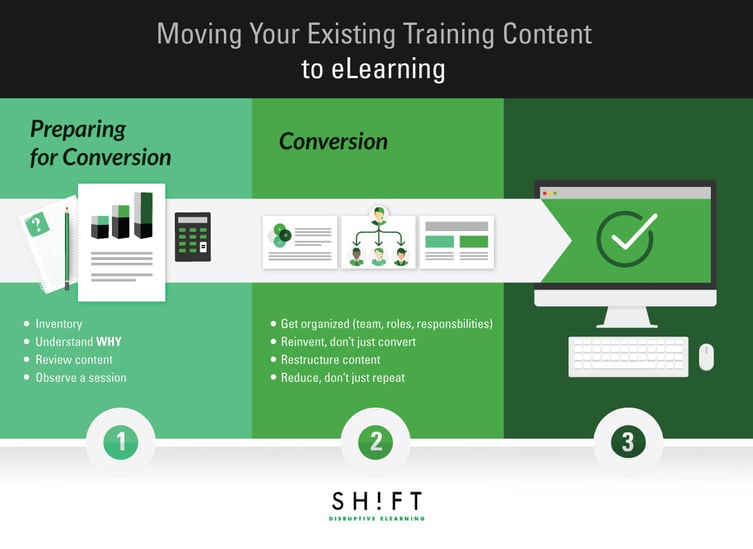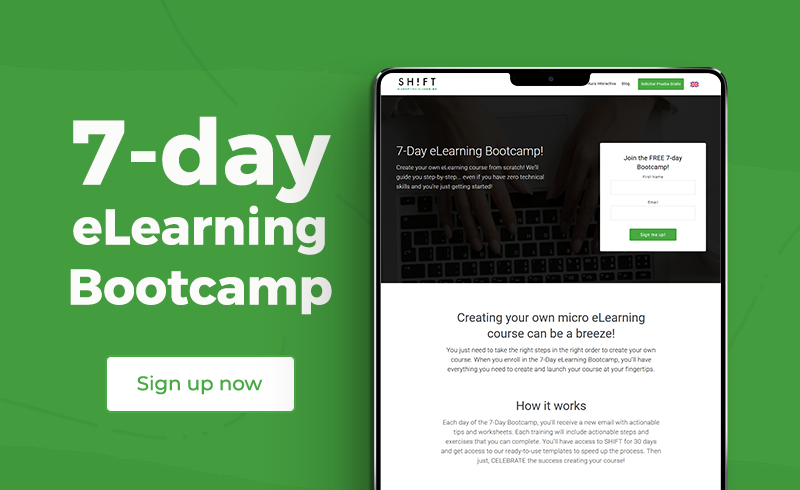If your company has been involved in delivering in-house training to staff for a while now, or if you are a freelance trainer or instructional designer who has been developing and offering Instructor Lead Training (ILT) to clients over the years; chances are that you may be sitting on a wealth of existing training materials.
With the new workforce circumstances, the evolution of eLearning, and modern learner new expectations, wouldn’t it be great to start moving some (or all) of that content into the online training arena?
If you are interested in making that leap, here’s how you should proceed:
Preparation Phase:
Successfully moving existing training content to fit the eLearning model requires some prep work. If you just start the transformation process by doing a one-for-one conversion (i.e. taking each slide or presentation deck and making an exact digital representation of it); chances are that you’ll end up with an eBook without delivering an enhanced learning experience to your learners.
Here’s what you should consider when preparing for the conversion:
1) Prepare a detailed inventory of what you have:
Instructor Lead Training (ILT) usually comprises of projected slides (either transparency-based or digital media like PowerPoint), hand-outs, workbooks, course notes, audio and video files, and worksheets. There may be other auxiliary materials too, like answer sheets, student guides, and feedback forms. As your first step, you need to assemble all the material together for a successful eLearning conversion.
Read more: The Step-by-Step Guide to Conducting a Content Inventory for eLearning
2) Understand why the course was originally created:
Every successful “How” is preceded by an in-depth understanding of the “Why.” By understanding why the eLearning course was devised in the first place, you may be able to get some vital clues about how you can ease its transition into the digital age.
For instance:
If existing Flow Charts were meant to help learners understand and then apply process flows to the proper procedure; then perhaps an interactive component may be developed where students can drag “flow” elements, and drop them into corresponding “procedure” elements online?
On the other hand, if those flows were meant to serve as reference material to use on-the-job, then a digital re-creation, complete with hyperlinks and interactivity, and stored in a central repository, may serve the purpose.
3) Review and revise before conversion:
Now that you have all of the “raw materials,” it’s often tempting to immediately start transcribing what you have and converting it into digital media. Don’t!
Instead:
- Review all of the existing content to see if the information is accurate
- If possible, correct the misleading/outdated information or, at minimum, flag those parts for update/revision (by the team who will be converting it subsequently)
- Many instructor-led training often repeats key concepts and components of the course in the materials provided to learners. In today’s digital world, it’s simpler to just link back to previous content instead of converting it multiple times. Such opportunities should be flagged for the conversion team too.
Also read: Best Practices to Convert Instructor-Led Training to eLearning
4) Observe a session…if possible
If there is a training session in progress, that uses the current materials, it may be very valuable for key members of your conversion team to sit-in and observe it. Doing so will:
- Provide the conversion team a unique insight on how to turn some of the paper-based materials into digital content
- Help the team identify critical user-interface design aspects in the online course
- Identify potential information “gaps” in the existing content (for example, if learners continually ask for clarification on specific content), which can be plugged during the conversion process (e.g.: By adding a FAQs section online)
Conversion Phase:
Your prep steps have set the stage to carry out the actual conversion:
1) Get organized
To make the entire ILT To eLearning conversion process highly effective, you need to get yourself organized first:
- Ensure that you have identified all members of your team, including instructional designers (IDs), Subject Matter Experts (SMEs) and support staff.
- Assign clear roles and responsibilities for each member of the team, including defining areas where there may be a joint responsibility, such as identifying project goals and timelines.
Read more: 7 Factors For Ensuring a Successful eLearning Implementation
2) Reinvent…Don’t just convert
Conversion is an excellent opportunity to rethink the purpose of all of your existing content. You might be pleasantly surprised at how much opportunity there is to reconfigure existing content to make it more user-friendly and better adaptable to eLearning.
- Do you have excessive text and descriptive content? Could some of it be converted into graphics, images or pictures? Could some of it be discarded?
- Are there static images followed by massive paragraphs of text, leaving learners to flip back and forth between images and textual content? Perhaps introducing “mouse over” functionality or including “Hotspot” interactions will produce a better learning experience. Learners can simply hover the mouse pointer over parts of the graphics, and the pop-up text will explain what they are looking at – all on the same slide!
- Good instructional design practices suggest better eLearning outcomes are achieved with multi-media courses. Consider doing away with exhaustive text-based content, and substitute some of it with voice-over or even creating your own videos in-house.
3) Restructure…Don’t just adopt
Don’t blindly adopt the same course flow that your existing ILT content uses. While ILT is trainer-driven, most eLearning courses are self-driven. As a result, you need to put more control into the hands of the learner.
- Restructure your course content to be served on-demand
- Allow specific segments of the course to be skipped, depending on a student’s choice and their “maturity level.”
Read more: 3 Big Don’ts When Converting Instructor-Led Training to eLearning
4) Reduce…Don’t just repeat
The easiest thing to do in a conversion exercise is to repeat existing content verbatim, and put it on a server for consumption. Good instructional design practices, however, don’t support that approach.
- Simplify text to the extent that it doesn’t overwhelm the reader. A crowded screen is a good way to disengage online learners quickly! Also read: 6 Essential Graphic Design Principles to Guide Your eLearning Course Design
- Break-up large lessons into multiple parts, making each sub-module no longer than 12 to 15 minutes in duration. You may find these Cue Sheets helpful to guide you through converting Learning content.
- Instead of summarizing content repeatedly, consider adding a sidebar to the course, where Module, Chapter and Course Summaries can be accessed on demand
While “conversion” is your ultimate goal, moving existing learning content into the digital era shouldn’t be about transcription. The objective should be reuse, repurpose and recycle, but also to leverage newer technologies and good instructional designing practices in doing so.




